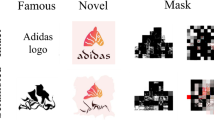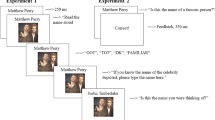Summary
In this paper we report five experiments that investigate the influence of prime faces upon the speed with which familiar faces are recognized and named. Previously, priming had been reported when the prime and target faces were closely associated, e.g., Prince Charles and Princess Diana (Bruce & Valentine, 1986). In Experiment 1 we show that there is a reliable effect of relatedness on a double-familiarity decision, even when the faces are only categorially related, e. g., Kirk Douglas and Clint Eastwood. Then it was shown that such an effect emerges only on a double decision task (Experiments 2 and 3). Experiment 4 showed that on a primed naming task, faces preceded by a categorially related prime were responded to more quickly than those preceded by an unrelated prime, and the effect was due to inhibition. Experiment 5 replicated this effect and also showed that when associatively related primes were used, a facilitatory, and not an inhibitory, effect is found. It is argued that the facilitation of associative priming arises at an earlier locus than the inhibition of categorial priming.
Similar content being viewed by others
References
Becker, C. A. (1980). Semantic context effects in visual word recognition: An analysis of semantic strategies.Memory & Cognition, 8, 493–512.
Brennen, T. (1988). Semantic priming in face recognition: Is the effect truly a semantic one? Paper presented to the Joint Conference of the European Society of Cognitive Psychology/British Psychological Society — Cognitive Psychology Section, Cambridge, September.
Bruce, V. (1983). Recognising faces.Philosophical Transactions of the Royal Society of London, Series B, 302, 423–436.
Bruce, V. (1988). Recognising faces. Hillsdale, NJ: Lawrence Erlbaum Associates.
Bruce, V., Dench, N., & Burton, A. M. (1991). Effects of distinctveness, repetition, and semantic priming on the recognition of face familiarity. Manuscript submitted for publication.
Bruce, V., & Valentine, T. R. (1986). Semantic priming of familiar faces.Quarterly Journal of Experimental Psychology, 38A, 125–150.
Bruce, V., & Young, A. (1986). Understanding face recognition.British Journal of Psychology, 7, 305–327.
Ellis, A. W., Young, A. W., & Flude, B. (1990). Repetition priming and face processing: Priming occurs within the system that responds to the identity of a face.Quarterly Journal of Psychology, 42A, 495–512.
Fischler, I. (1977). Semantic facilitation without association in a lexical decision task.Memory & Cognition, 5, 335–339.
Hanley, J. R., & Cowell, E. (1988). The effects of different types of retrieval cues on the recall of names of famous faces.Memory & Cognition, 16, 545–555.
Huttenlocher, J., & Kubicek, L. F. (1983). The source of relatedness effects on naming latency.Journal of Experimental Psychology: Learning, Memory and Cognition, 9, 486–496.
Kroll, J. F., & Potter, M. C. (1984). Recognising words, pictures and concepts: A comparison of lexical, object and reality decisions.Journal of Verbal Learning and Verbal Behavior, 23, 39–66.
Lupker, S. J. (1984). Semantic priming without association: A second look.Journal of Verbal Learning and Verbal Behavior, 23, 709–733.
Lupker, S. J. (1988). Picture naming: An investigation of the nature of categorical priming.Journal of Experimental Psychology: Learning, Memory and Cognition, 14, 444–455.
Neely, J. H. (1976). Semantic priming and retrieval from lexical memory: Evidence for facilitatory and inhibitory processes.Memory & Cognition, 4, 648–654.
Sternberg, S. (1969). The discovery of processing stages: Extensions of Donder's method.Acta Psychologica, 30, 276–315.
Thomson, D. (1986). Face recognition: More than a feeling of familiarity? In H. D. Ellis, M. Jeeves, F. Newcombe, A. Young (Eds.),Aspects of face processing. Dordrecht: Nijhoff.
Young, A., Ellis, A., Flude, B., McWeeny, K., & Hay, D. (1986). Face-name interference.Journal of Experimental Psychology: Human Perception and Performance, 12, 466–475.
Author information
Authors and Affiliations
Rights and permissions
About this article
Cite this article
Brennen, T., Bruce, B. Context effects in the processing of familiar faces. Psychol. Res 53, 296–304 (1991). https://doi.org/10.1007/BF00920483
Received:
Accepted:
Issue Date:
DOI: https://doi.org/10.1007/BF00920483




